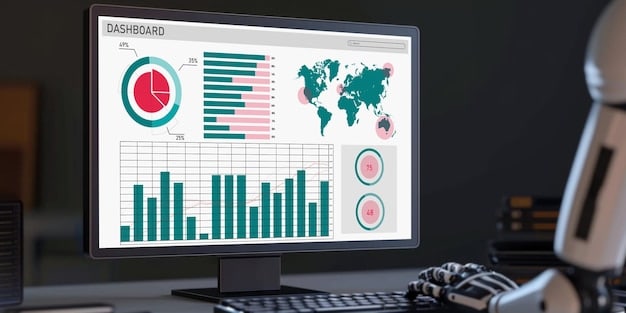E-commerce Platform Scalability: Handling Holiday Traffic Surge in the US

E-commerce Platform Scalability: How to Handle a 30% Increase in US Holiday Season Traffic involves strategic planning and infrastructure adjustments to ensure seamless user experience and prevent revenue loss during peak demand. Implementing solutions like cloud-based services, efficient caching, and load balancing are crucial for maintaining performance.
The holiday season in the US is a crucial period for e-commerce businesses, often bringing a significant surge in traffic. Are you prepared to handle a 30% increase? Understanding and implementing effective strategies for E-commerce Platform Scalability: How to Handle a 30% Increase in US Holiday Season Traffic is essential for a successful holiday season.
Without proper scalability, online stores risk slow loading times, site crashes, and ultimately, lost sales. Let’s explore the critical steps to ensure your platform can handle the holiday rush.
Understanding the Importance of E-commerce Platform Scalability
Scalability is the ability of an e-commerce platform to handle increased traffic and transactions without compromising performance. For US-based businesses, the holiday season is a stress test, demanding robust E-commerce Platform Scalability: How to Handle a 30% Increase in US Holiday Season Traffic to maintain optimal operation.
Why Scalability Matters During the Holidays
During peak seasons, a lack of scalability can lead to several issues:
- Slow Loading Times: Frustrated customers are likely to abandon their carts.
- Site Crashes: Complete downtime can result in significant revenue loss.
- Poor User Experience: Negative experiences can damage your brand reputation.
- Lost Sales: Inability to process transactions efficiently directly impacts revenue.
Investing in E-commerce Platform Scalability: How to Handle a 30% Increase in US Holiday Season Traffic is not just about surviving the holidays; it’s about providing a consistently positive shopping experience that builds customer loyalty.
By preparing your infrastructure and optimizing your site, you can ensure smooth operation and maximize sales during the busiest time of the year.
Assessing Your Current Platform’s Capabilities for E-commerce Platform Scalability: How to Handle a 30% Increase in US Holiday Season Traffic
Before strategizing for scalability, assessing your current platform’s capabilities is crucial. Understanding its strengths and weaknesses will help you identify areas needing improvement to achieve E-commerce Platform Scalability: How to Handle a 30% Increase in US Holiday Season Traffic effectively.
Conduct a Performance Audit
Start by conducting a thorough performance audit. This includes:
- Load Testing: Simulate peak traffic to identify breaking points and bottlenecks.
- Monitoring Key Metrics: Track response times, server load, and database performance.
- Analyzing User Behavior: Understand how users interact with your site during high-traffic periods.
Utilize tools like Google Analytics, Pingdom, or New Relic to gather data on your platform’s performance. This data will provide valuable insights for making informed decisions.
Identify Bottlenecks and Weaknesses
Once you have performance data, pinpoint any bottlenecks or weak points. These might include:
Addressing these issues is fundamental to improving your platform’s scalability. Prioritize areas that have the most significant impact on user experience and revenue.
Regular assessments and audits are essential to proactively identify and mitigate potential issues before they impact your business during the crucial holiday season.

Key Strategies for Achieving E-commerce Platform Scalability During Peak Seasons
Achieving E-commerce Platform Scalability: How to Handle a 30% Increase in US Holiday Season Traffic involves implementing strategic solutions across your technology infrastructure. These strategies are designed to ensure seamless performance and prevent disruptions during peak seasons.
Leverage Cloud-Based Services
Cloud computing offers scalable resources that can be adjusted on demand.
Cloud-based services enable you to quickly scale up resources during the holiday season and scale down afterward, optimizing costs efficiently.
Optimize Caching Mechanisms
Caching stores frequently accessed data, reducing the load on your servers.
Efficient caching strategies can significantly improve website performance and reduce server load.
Implement Load Balancing
Load balancing distributes traffic across multiple servers, preventing any single server from becoming overloaded.
By distributing traffic evenly, load balancing ensures optimal performance and redundancy.
By implementing these strategies, you can significantly enhance your e-commerce platform’s scalability and ensure it can handle the increased demands of the holiday season.
Optimizing Your E-commerce Platform for a 30% Traffic Surge
Optimizing your e-commerce platform is critical for handling a 30% traffic surge during the US holiday season. Strategic measures can ensure your platform maintains performance, delivers a seamless user experience, and maximizes conversion rates. Addressing key areas such as code efficiency, database optimization, and mobile responsiveness is essential for effective E-commerce Platform Scalability: How to Handle a 30% Increase in US Holiday Season Traffic.
Code Optimization
Efficient code reduces server load and improves website speed.
Clean and efficient code can significantly enhance website performance.
Database Optimization
A well-optimized database ensures fast data retrieval.
Efficient database management is crucial for handling large volumes of transactions.

Mobile Optimization
With a significant portion of online shopping occurring on mobile devices, optimizing for mobile is essential.
A seamless mobile experience is critical for capturing sales during the holiday season.
Through these techniques, you can ensure your e-commerce platform is not only scalable but also optimized for performance, providing a superior user experience and maximizing sales during peak traffic periods.
Monitoring and Testing Your Scaled E-commerce Platform
Continuous monitoring and rigorous testing are essential components of E-commerce Platform Scalability: How to Handle a 30% Increase in US Holiday Season Traffic. These practices ensure your platform performs optimally during peak seasons and that any potential issues are quickly identified and resolved.
Real-Time Monitoring
Implement tools for real-time monitoring of your platform’s performance.
Real-time monitoring provides immediate insights into your platform’s health and performance.
Regular Load Testing
Regularly conduct load tests to simulate peak traffic conditions.
Load testing helps you proactively identify and resolve potential scalability issues.
Create a Rollback Plan
Having a rollback plan is crucial in case of unforeseen issues.
A well-defined rollback plan minimizes the impact of any potential problems during the holiday season.
These monitoring and testing practices are indispensable for ensuring your scaled e-commerce platform can reliably handle the holiday season traffic surge.
| Key Point | Brief Description |
|---|---|
| 🚀 Cloud Services | Use cloud platforms like AWS/Azure for scalable resources. |
| ⚡️ Caching | Implement CDN and browser caching to reduce server load. |
| ⚖️ Load Balancing | Distribute traffic across multiple servers to avoid overload. |
| 📈 Monitoring | Monitor server performance and application during peak times. |
Frequently Asked Questions (FAQ)
It refers to the ability of an e-commerce platform to manage increased traffic and transaction volumes during peak seasons like the US holidays, ensuring optimal performance and preventing slowdowns or crashes.
Scalability ensures the platform can handle unexpected surges in traffic and transactions without compromising performance, preventing lost sales and maintaining customer satisfaction, which are very important factors.
Cloud services offer on-demand scalability, allowing businesses to increase resources during peak times and decrease them afterward, optimizing costs and ensuring seamless performance.
CDNs distribute content across multiple servers globally, reducing latency and ensuring faster loading times for users, regardless of their location, which enhances user experience.
Load balancing distributes incoming network traffic across multiple servers, preventing any single server from becoming overwhelmed and ensuring optimal response times even during a peak in platform activity.
Conclusion
Successfully managing E-commerce Platform Scalability: How to Handle a 30% Increase in US Holiday Season Traffic is vital for any e-commerce business in the US. By understanding the importance of scalability, assessing your current capabilities, and implementing key strategies like cloud services, efficient caching, and robust monitoring, you can ensure your platform is ready for the holiday rush.
Investing in these areas will not only help you survive the peak season but also provide a seamless and positive shopping experience, building customer loyalty and driving long-term success.





